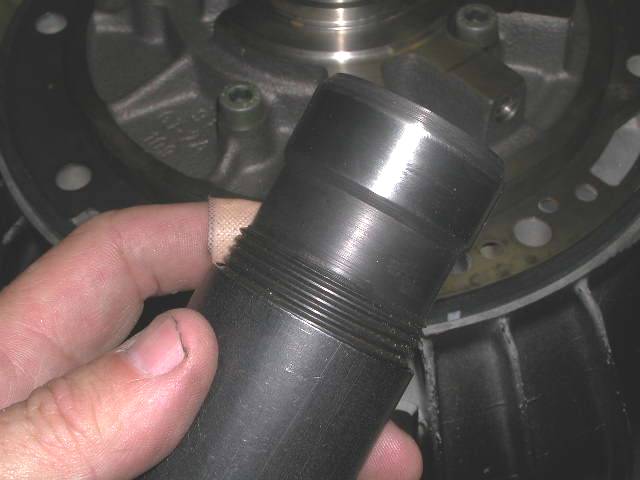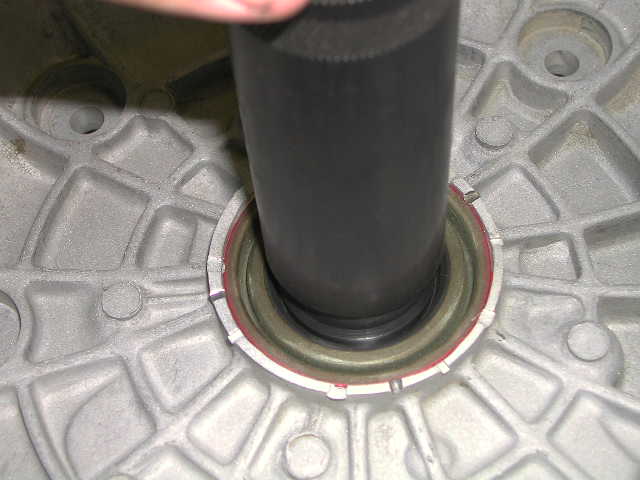Low / Reverse Servo
One of the last things to go back in is the low reverse servo. This is the servo that actuates the rear most band - in older Explorers it is the main cause of that 1/2 to 1 second delay in engagement when you move the shift lever from park to either R or D. What causes that is a leaky seal. FORD used an O-ring seal there. Later (and still trying to figure out it FORD did this or if it was aftermarket) a different kind of seal - a "double lipped seal" was used to help prevent leakage. (LIP seals are inherently better at sealing higher pressures than are o-rings). Maybe this is a good place to start, to look at the O ring and double lip seal:
The difference is apparent. Here's another view..
Most rebuild kits these days are coming with the double lipped seal. I am still trying to determine if FORD ever made them, and if so the part No. but without success so far.
Now lets look at the piston and rod assembly... there are two seals.... the big one (double lipped in our case) and a smaller one for the inner bore..
Maybe a good place to see them is in this pic....with the servo piston and rod in a vise...
WHY in a vise you ask? Well, with some hesitation (mainly because I cannot fully comprehend what benefits it gives or why) there is a MOD to this servo that I have decided to try. I'm going to show you this MOD now, but caution you to wait and dry fit the piston all together to get a feel for the proper play in it before you take it apart. It is impossible to do once you have taken it all apart and done the MOD. SO - here is the MOD but if you are going to do it, DO THE MOD AFTER YOU CHECK PROPER PLAY with an intact servo!
The mod involves disassembly of the piston. There is a spring inside the piston you do not see. To get it apart you put it in a vise and tighten the vise until the snap ring at the end of the shaft can be removed. Snap ring? More of a circlip...
and something of a PITA to remove. I ended up using 2 small screwdrivers. The ring will FLY when you take it off, so be careful not to send it into orbit.
Here is the stock piston apart
It consists of the turned aluminum piston, a spring, a stepped rod and the washer on the rod (plus the absent circlip). In the mod, you replace the longish spring shown with a shorter, stronger one, and reassemble WITHOUT the circlip. Here is a pic of the new spring on the rod
and here is the parts laid out... left of the rod are the old parts disassembled, to the right is the new MOD spring and an assembled piston assembly...
when you assemble it using the new spring without the clip, the inner spring portion will sit slightly proud, like so..
(apologies for pic focus)
SO, anyway that's the MOD.... BUT... before you do that (if you choose to - I am still trying to figure out exactly what it does as a benefit - if someone knows IM me and I'll include it here) be sure and use the fully assembled piston to check out our play.
GAUGING THE LOW INTERMEDIATE SERVO/BAND TRAVEL
This is a tough call for me. By gauging I discovered that I had the reverse band slip out of position and was able to maneuver it back without disassembling the transmission. Had I sinply ignored gauging I might never had found that. THEN I gauged without everything in place and came up with a number for piston travel that was NOT GOOD [piston travel should be between .120 and .220]. Bought a new sized LR assembly and THEN discovered I had gauged it wrong. Result, old one was JUST FINE. So...
how critical is this? I'm guessing not very. BUT, since I have the tools to do it, I will, and drag you along with me in the process, ok ?
I'll need to add some pictures maybe... but... with the valve body in place, and using the gasket for the cover ... add the gauge over the installed servo piston/rod... press the servo down and tighten the screw... to a mild hand tighten (35 INCH lbs!)... add a dial indicator and zero it...
then unscrew the bolt in the gauge and measure how far UP the piston/rod come (now you see WHY you need a unitized assembly, not a modified one)
This was one revolution plus .020... perfect... (the desired range is .120 to .220)
Now we will add the modded rod setup ... in other words the rod, the washer and the Mod spring.. centered on the rod and washer as best we can...
Next we'll add the piston and spring...
which we follow with the new gasket and cap... which I have npo pic of because it takes 2 hands.... anyway piece of cake, the spring is easily overcome.... once in torque it to 90 inch lbs too... and voila you're done...
 I may be tearing into mine this winter.
I may be tearing into mine this winter.









































